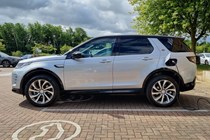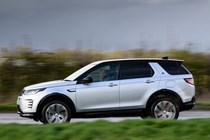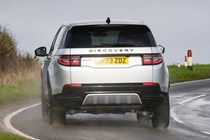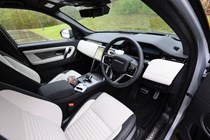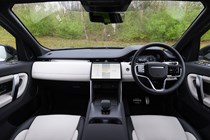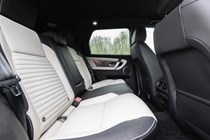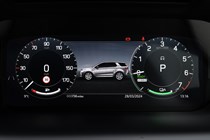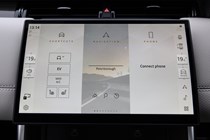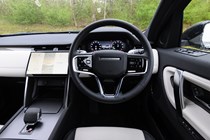
Land Rover Discovery Sport long-term test
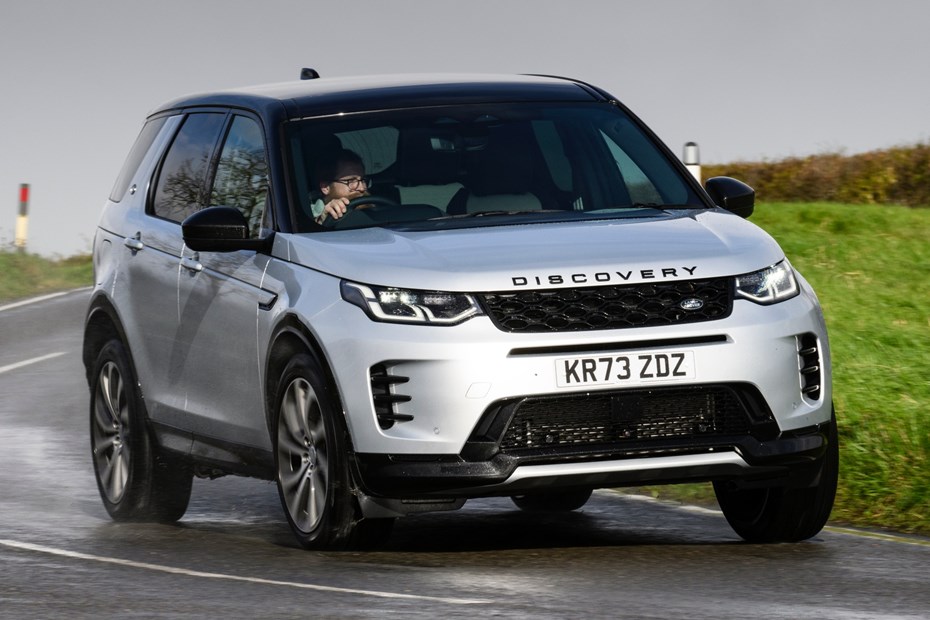
Parkers’ new cars editor Alan Taylor-Jones is running a Land Rover Discovery Sport P300e to see what it’s like to live with. A young family means boot space is important, and there needs to be room for grandma and grandpa. Can the plug-in powertrain impress, and do 2023’s revisions actually improve the Disco Sport?

Update 1: Welcome
Introducing my long term Land Rover Discover Sport P300e Dynamic SE
Testing a car for a few hours can tell you an awful lot. Extend that period to a week, and you’ve got a pretty complete picture of what it’s like. However, if you really want to get under the skin of something, you need a few months to get to know what you couldn’t live without, and whether there are any deal breaking annoyances.
So that’s what I’m doing here, living with a Land Rover Discovery Sport over four months to see how it stacks up as sensible yet desirable family conveyance. It’s a post-2023 facelift P300e plug-in hybrid in mid-spec Dynamic SE trim, making it a very different proposition to the oil-burning Discovery Sport D240 editor Keith Adams ran back in 2019.
I picked the PHEV because I’ve got a home wallbox so it’s easy to keep it topped up, even if I have to make a couple of errands in a day. I also don’t need seven seats, certainly not ones as tiny as those found in the Disco Sport. I’m 5′ 4″ and even I feel hemmed in. Swift acceleration is also something both my wife and I value, so having the quickest model of the lineup also appealed.
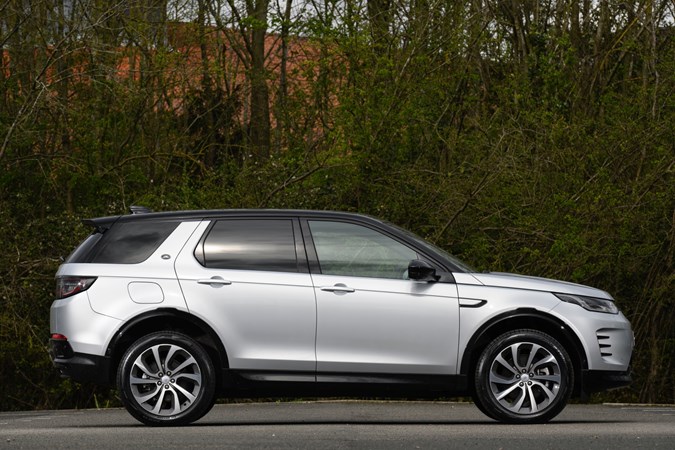
The 1.5-litre turbocharged petrol engine is smaller than those found in most rivals, but still chucks out a useful 200hp on its own. There’s also a 109hp electric motor for the rear wheels to give a total system output of 309hp. A 15kWh battery isn’t as big as many rivals these days, giving a claimed all-electric range of 36.7 miles. We’ll come back to those claims in a later update.
What you get as standard with a Discovery Sport Dynamic SE
My Disco Sport’s base price is a fairly hefty £52,645, although both diesels dip comfortably below £50k. Look around the leather-lined cabin and consider this car’s off-road ability, and you can start to justify that price. That said, there are a lot of options to help make it plusher and more user friendly.
Here are 10 features of note that are standard:
- Heated windscreen
- Front and rear parking sensors with a rear camera
- Adaptive cruise control
- Two-zone climate control
- An electric tailgate
- Wireless smartphone charging
- Keyless entry and start
- Apple CarPlay and Android Auto
- LED headlights with automatic main beam
- Heated front seats
Optional extras
A few tasty options have made their way onto my Disco Sport, bumping up the list price by over £7,000. Here’s what I’ve got, and whether I think it’s worthwhile so far:
Driver assist pack
Worth it for the blind spot monitoring alone, although the rear traffic monitor is occasionally a bit too sensitive for my liking.
Black roof rails
I don’t feel the need to strap anything to the Disco Sport’s roof, but you may feel differently.
Electrically deployable towbar
With no trailer or caravan at my disposal, this will go unused as well, although it is easy to deploy.
Headlight power wash
As the headlights always feel strong and I never manually clean them, I’d say this works.
Fixed panoramic roof
You get a choice of a steel roof or a fixed glass one with a blind. As the glass costs no extra and makes for a fair airier cabin, it’s a no brainer in my opinion.
3D surround camera
Not the sharpest camera system I’ve used, but a high enough resolution to be useful. One to at least consider.
Clearsight rear view mirror
This allows you to flip between a normal mirror or a camera feed from the back of the car. Useful if it was loaded to the roof. At all other times I use the conventional mirror.
Heated rear seats
Went down very well with the grandparents.
Heated steering wheel
I will always select one of these if it’s available.
Meridian surround sound system
Sounds terrific and isn’t hideously expensive.
Tyre repair system
Sod’s law says if I’ve got it, I won’t need it.
Secure Tracker Pro
Given Land Rover’s reputation for being easy to steal, this seems very sensible.
With 20-inch diamond-turned alloy wheels and metallic silver paint factored in, the total is £59,825. That’s a hefty sum of money to pay up or finance, and at the time of writing it sits in the 12% bracket for company car tax. A number of rivals sit in the 8% bracket, with others such as the Mercedes GLC 300e going as low as 5%. We’ll find out if it’s worth the expenditure over the next four months.
Update 2: Interior, space and practicality
What’s it like inside, and how spacious is it?

As many of you will know, it’s impossible to pack light if you’ve got young children. That can be problematic with many plug-in hybrids as boot space gives way to big battery packs, something that isn’t the case with the Discovery Sport.
It’s not until you’ve loaded a folding cot, feeding chair, playpen, bubble gun, a suitcase and plenty more besides that you truly appreciate how big the Discovery Sport’s boot is. Plug-in hybrids get the fixed rear bench, but diesel buyers can opt for a sliding and reclining rear bench that allows you to prioritise boot space at the expense of rear legroom.
A netted-off nook is the perfect place to stash suncream, a few emergency nappies and some wet wipes, and there’s a sizeable underfloor storage area. It’s a great place to stick the charging cables, and there’s still enough space for a couple of radio controlled cars. This area is swallowed up by a spare wheel if you option one, though.
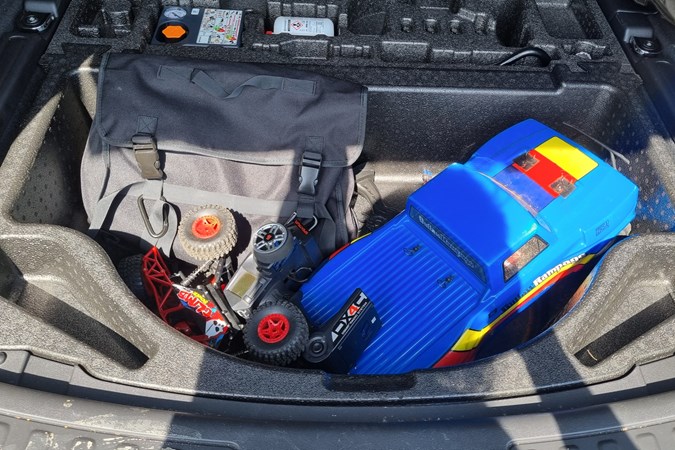
Space for people is good, too. Front seat passengers still have decent legroom with a rear-facing child seat behind them, and those in the back have good head and legroom. Five-up, the centre rear seat is rather flat and there’s a bit of a transmission tunnel to deal with.
Does it feel worth the money inside? On the whole, yes. The two-tone leather looks good, feels supple and even the light bits scrub up well if they’ve been toddlered. I like the metal-effect trims, soft materials from hip level and above, and how this decade-old platform still feels modern inside.
However, that modernity comes with issues. The pre-facelift car’s touch-sensitive panel for most heater controls wasn’t our favourite, but it was redeemed by simple dials for the temperature, and with a prod, the seat heating, too. That panel has met the bin, opening up the dashboard whilst pushing the heating controls into the touchscreen.
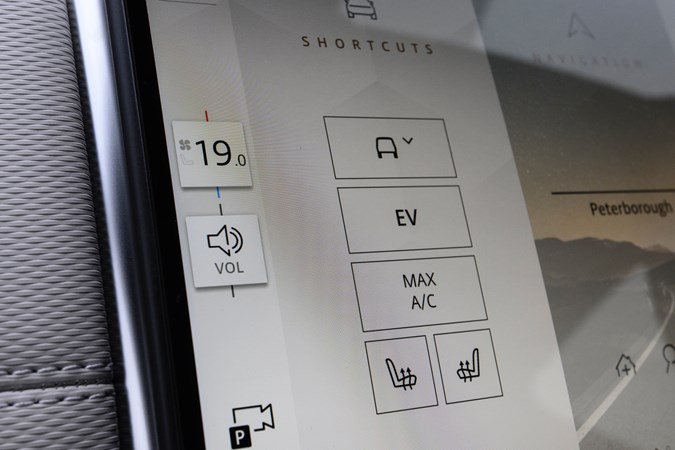
Temperature controls stick to the outer sides of the screen, as do the controls for the heated seats. Even so, the icons are tiny and take far more of your attention than the old setup. It’s a massive backward step for usability, and shouldn’t you be able to control everything with your gloves on in a ‘proper’ Land Rover anyway?
That said, the infotainment system is good. I think the graphics look suitably upmarket and the screen’s resolution is certainly sharp. Its quick to respond to commands and has Android Auto, which I tend to use anyway. To further connect with the car remotely, I downloaded the InControl app.
This has proved handy on a number of occasions, allowing us to quickly check the car’s range from our sofa to better plan outings, lock and unlock it without a key, and turning on the air-conditioning on a hot day. It’s well worth a few minutes of downloading and signing up.
Update 3: Engine, driving and running costs
What are the realities of the plug-in powertrain?

Although we think the D200 diesel is the engine of choice in the Discovery Sport, I was keen to try the P300e plug-in hybrid for a couple of reasons. For a start, editor Keith Adams previously ran a diesel Disco Sport back in 2019, and the PHEV is now the only other choice. Besides, I’ve come to like a plug-in hybrid over the last few years.
There’s something appealing about the quiet and locally clean nature of electric drive, and the convenience of just plugging it in at home to extend the range by 30 miles or so. I never match the official figures, with 30-31 miles possible if you kept your average speed down, dropping to the high twenties if you through in some faster A roads.
Things have progressed somewhat since this hybrid system was conceived, though. The cheaper Volkswagen Tiguan eHybrid has an electric range of over 55 miles in the real world, and a Mercedes GLC 300e is similarly impressive. Those cars also have more powerful electric motors so you’re less likely to wake the petrol engine if you suddenly need a burst of acceleration.

The Discovery Sport seemed to wake its petrol engine on almost every journey. One of the key routes out of our village involves joining a busy, fast flowing roundabout on the A47, and the 109hp electric motor just wasn’t punchy enough. It’s not like the engine shuts straight off either, seemingly needing to get up to operating temperature before it’ll go back into EV mode.
While you’d think a dinky three-cylinder engine would be fuel efficient, it just isn’t in this. Economy with a flat battery in hybrid mode is in the low 30s, and we’ve been averaging just under 55mpg after a couple of thousand miles. You can rapid charge the battery at 50kW for a 0-80% time, but that works out as more expensive than the petrol you’re trying to save.
I’ve no complaints regarding the performance once you overcome an initial hesitation from the engine room. It’ll start accelerating on the electric motor if there’s charge while the gearbox pauses for a moment, then delivers the ICE efforts to the front tyres. It’s a problem made worse if the engine’s off, although Sport mode always seems to wake it up. Useful if you’re planning an overtake on one of the many arrow-straight Fenland roads around here.
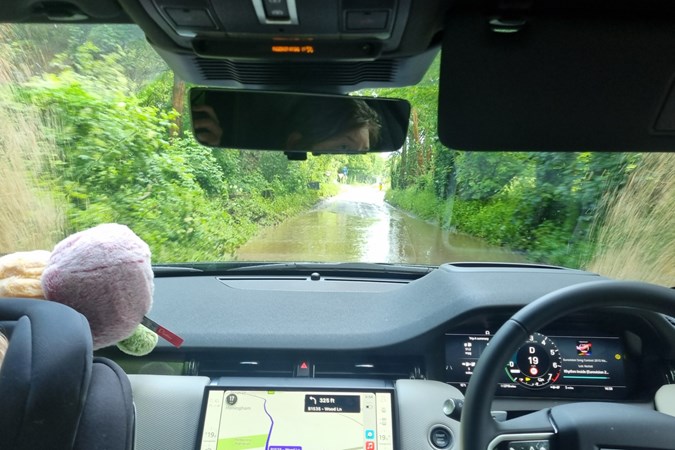
Ride comfort on these undulating stretches is for the most part good. It’s softly sprung and does without the clever air suspension of its more expensive siblings. Adaptive dampers are available on diesel models but I’ve got regular coils and fixed rate dampers, your only option on the PHEV. They don’t give the tight body control you’d find on a BMW X3 and I’m OK with that, although I do wish it dealt with bumpy urban surfaces a little better.
This is a quiet, comfortable and calming place to be so I don’t mind the all-season tyres have a bit less grip than regular ones on road-biased rivals, or that there’s a fair bit of lean in bends. You can hustle this along quickly enough if you need to, you just don’t want to. Besides, it’s satisfying enough to drive in normal use thanks to well-weighted steering and pedals and an easy to place nose.
There’s no doubt the P300e is an appealing thing that does offer low company car tax rates and potentially cheaper running costs than the diesel. That’s assuming you run it almost exclusively on electricity from cheap sources. It’s let down by its electric range which hurts both efficiency and its BIK tax rating. If I were a company car driver, I’d be looking at a Mercedes GLC 300e unless you really need the extra boot space.
Update 4: Verdict
Would I recommend a Discovery Sport P300e?
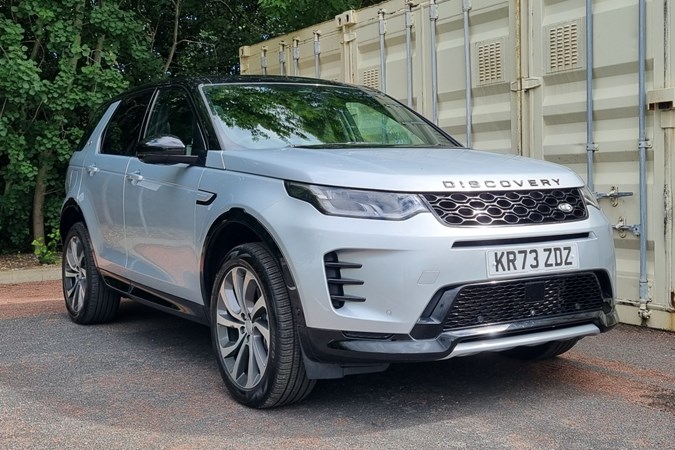
After four months and over 3,000 miles, our time with the Land Rover Discover Sport P300e is up. Will I miss it? Yes, because although it isn’t perfect, it is a well thought out family car that ticks an awful lot of boxes.
Whoever designed the interior clearly had family life in mind. Plenty of sensibly sized cubbies and big door pockets meant there was always room for one more item, and it was a similar story with the boot. Having the underfloor storage made it easy to separate fragile items and it was somewhere to sling the cable, too. Unlike most rivals there’s no boot space penalty for picking the plug-in hybrid.
Space for people also impressed, with rear width with three aboard the only complaint. That’s to be expected for this size of car, and I certainly didn’t miss the diesel’s optional third row of seats which is just too cramped. So, is the plug-in the Discovery Sport to pick? I’m not so sure.
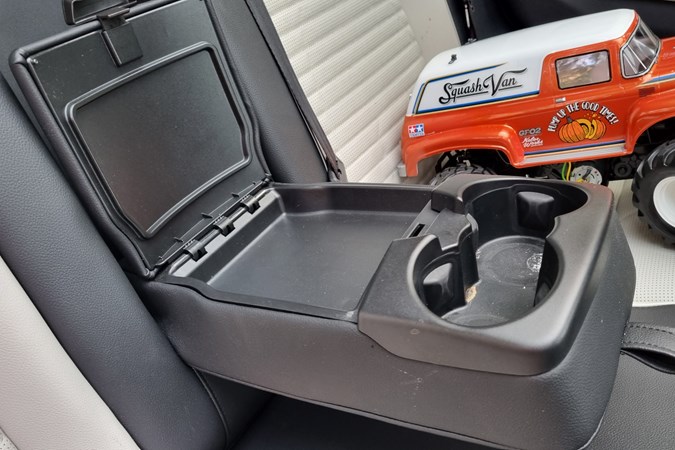
In isolation it’s decent enough. The additional pace the plug-in system brings is certainly welcome once you’ve dealt with the initial hesitation from the gearbox. Switching from electric to petrol is done smoothly – no guarantee in this class – and the battery range is useful. The trouble is, things have moved on in terms of battery size and hybrid system efficiency.
A Volkswagen Tiguan or Mercedes GLC PHEV has a far longer electric-only range that’ll not only save you petrol, it’ll save you company car tax. While my wife and I averaged 31 miles per charge in the Discovery Sport, over 50 is possible from the Tiguan in the real world. It’s the difference between me using the Discovery Sport’s engine for a quarter of my commute to the office, and potentially not at all in a Tiguan eHybrid. Given that I can charge at work for free, that’s a big saving.

Both the Tiguan and GLC are also far more frugal when you run out of volts, especially if you’ve picked the unusual diesel-electric GLC 300de plug-in hybrid. Our Discovery Sport would never rise above 34mpg with a flat battery However, the Volkswagen isn’t as good to drive or remotely capable off-road, while the GLC is even more expensive than the Land Rover and VW.
So, where does that leave the Discovery Sport P300e? It’s a tough one to recommend to company car drivers on account of its relatively high tax bracket. Even if you’re not worried about BIK rates, its limited electric range and thirsty, easy to wake engine make it more expensive to run than rivals. Unless you really must have the off-road ability, there are better plug-in hybrid rivals. If you must have a Discovery Sport, a diesel like Keith Adam’s old long-termer makes more financial sense.
| End mileage | 3,163 |
| Real-world average fuel economy | 53.8mpg (including electric running) |
| Official combined fuel economy (WLTP figures) | 141mpg |
| Parkers ‘MPP’ (Miles Per Pound) calculation | N/A |
| Car joined Parkers fleet | March 2024 |







